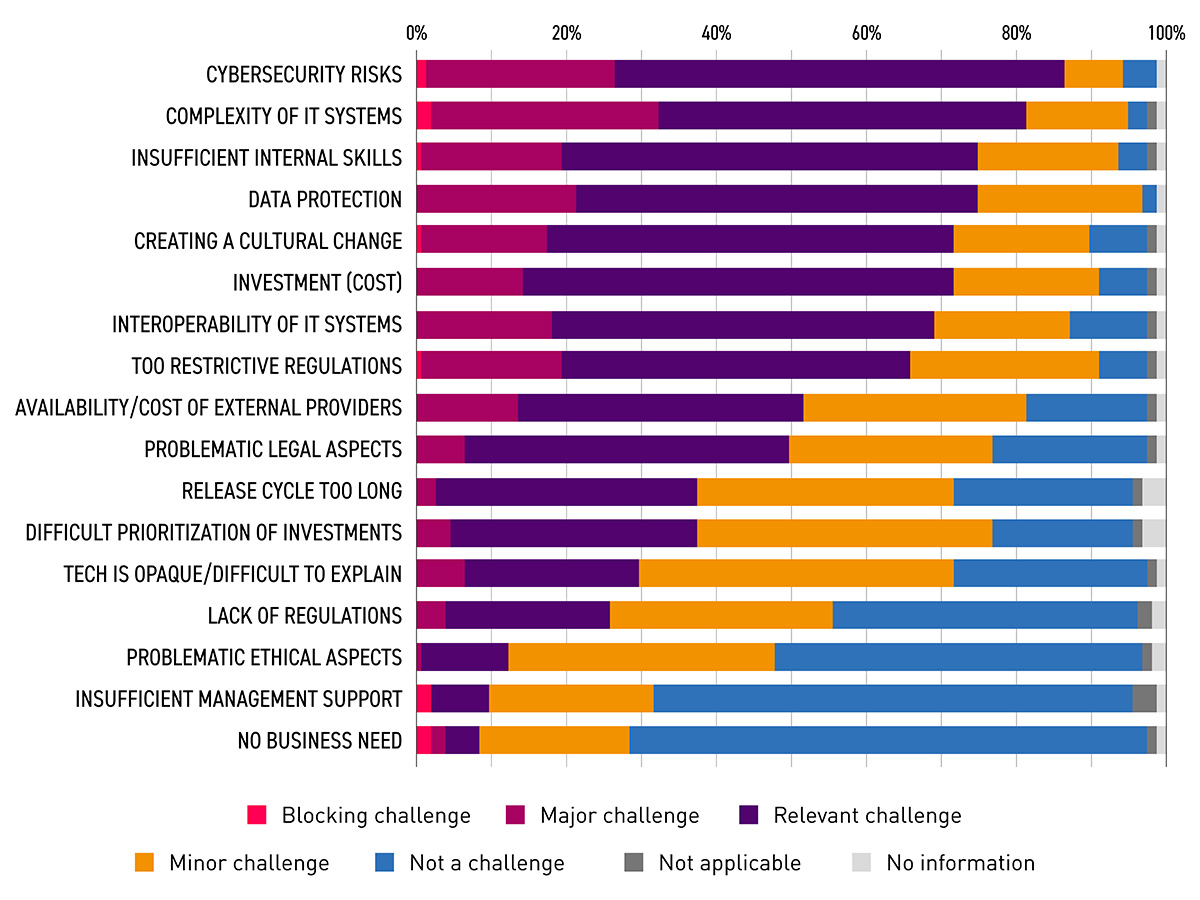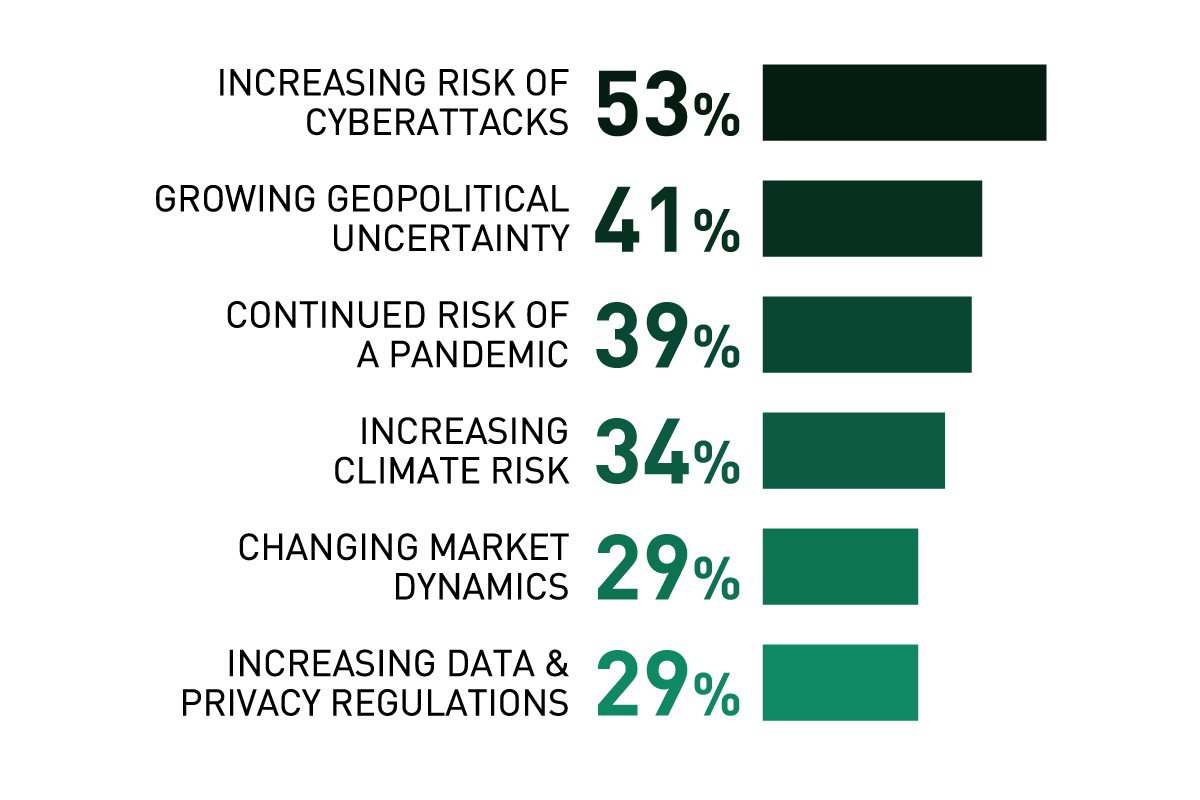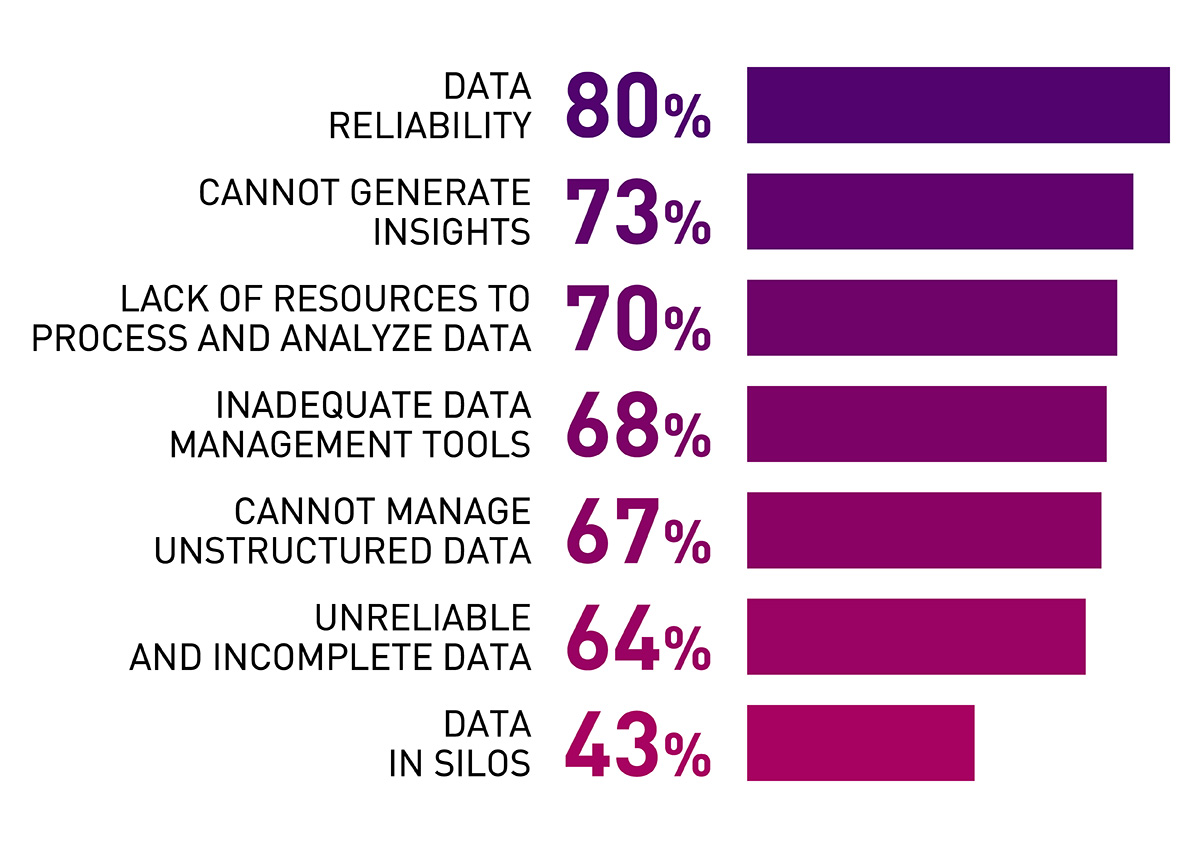
Top 7 challenges of digitization in the financial sector
Digital transformation is no longer just an option for banks, but a necessity to remain competitive and keep up with changing customer demands.
Financial services are undergoing a continuous digital transformation that goes far beyond providing digital services to customers through online banking. This change creates a myriad of opportunities for banks and insurers across all areas of their operations. This is the focus of our latest e-book, which you can download for free here.
However, in their digitization journeys, financial institutions face a number of challenges that can pose a significant threat to their efforts.
A recent survey of 105 large Eurozone banks by the European Central Bank’s Banking Supervision clearly showed which challenges are the biggest hurdles (Figure 1).
Figure 1: Major digitization challenges for European banks

Source: “Take-aways from the horizontal assessment of the survey on digital transformation and the use of fintech”; ECB Banking Supervision, February 2023
In general, the challenges can be divided into several groups including legal aspects, cybersecurity, technology solutions and software development process, necessary human resources and skills, investment costs, data collection and processing, as well as aspects related to cultural change in the organization.
Let’s discuss the most important ones, which are related to various IT issues.
1. Cybersecurity
The growing reliance of the financial sector on hardware and software solutions, the popularization of open banking as well as the increasing pressure from customers for the availability of online products and services are presenting financial institutions with an increasing number of cybercrime threats.
Every new system incorporated into an organization’s IT environment, every new API to share financial data and services with third parties or even the smallest web application can be a potential gateway for cyberattacks. Not to mention the entire arsenal of threats that can lie within the legacy systems that most financial institutions are teeming with.
The risk is all the greater as the sector increasingly makes use of software, hardware and IT services provided by third-party vendors and partners, including FinTech companies.
The most common threads include malicious software (viruses, worms, trojans, spyware, and ransomware which infiltrate a system), social engineering attacks to trick a user and acquire sensitive information (most popular are baiting, pretexting, and phishing), denial-of-service attacks to overload a system, as well as injection attacks to directly insert malicious input into the code of a web application.
System security vulnerabilities can result from errors or mistakes made during the development, configuration, deployment, maintenance or updating of an organization’s IT infrastructure. However, they can also be caused by people’s faults or carelessness when using software, hardware, mobile devices, instant messaging, email apps, websites, etc.
More than half of SAS survey respondents cited the growing risk of cyber attacks as one of the biggest threats facing their organization over the next decade (53%).(1) Notably, this concerns bank executives more than any other phenomenon, including recent crises — growing geopolitical uncertainty (indicated by 41% of respondents) and the specter of a returning pandemic (39%).
Figure 2: The greatest risks for banks during the next decade

Source: Banking in 2035: global banking survey report, SAS, 2022
This is not surprising, given the severity that cyberattacks can have. Already in 2018, in one of its studies, the International Monetary Fund estimated that average annual losses to banks from such attacks could be as high as $100 billion.(2)
In addition, companies in the financial sector face hefty fines for cybersecurity breaches, failure to comply with relevant regulations and guidelines, and even the actions of their employees who happen to inadvertently create digital risks.
An example is a $125 million fine imposed by the U.S. Securities and Exchange Commission (SEC) on J.P. Morgan Securities due to employees’ insecure practices, namely using WhatsApp and personal email accounts to transact official business.(3)
2. Technology
For a successful digital transformation, companies must have a range of technologies in place. And in doing so, they should not limit themselves to optimizing online access and platforms for their customers, as they did in the past.
Over the years, technology investments in the financial sector have focused on modernizing existing IT systems and optimizing the customer experience. Yet the processes and data flows that underpin the business have been far too neglected.
If you want to achieve higher growth and better UX, you have to create the necessary conditions internally. This starts with the critical review of workflows, continues with the establishment of AI-supported data analysis and exploitation, and continues with the use of cloud-based platforms.
Many experts even believe that the future of banks lies beyond traditional banking – rather in additional services based on the extensive data, knowledge and experience that these organizations possess.
This requires cutting-edge technologies including Artificial Intelligence (AI) and advanced data analytics. It is therefore not surprising that business intelligence (BI) and data analytics are key investment areas that are gaining importance in the financial sector. 64% of insurance company CIOs surveyed plan to spend more on these areas in 2023 (an 8-percentage point increase from 56% in 2022).(4) The same is true for banks, where BI/data analytics appear in the investment plans of 59% of CIOs (up from 51% in 2022).(5)
Technologies such as AI and machine learning are the most likely to be implemented by 2025, according to IT executives (cited by 99% of insurance CIOs and 95% of banking CIOs).
In order to use this expenditure sensibly, the right data strategy is required, including data governance and master data management (MDM). This is the only way to meaningfully standardize, integrate, protect, and store data.
The ideal uses of advanced analytics as well as artificial intelligence and use cases of digitization can be found in our free e-book.
3. Data management
Unlike trade companies, data management is not just an opportunity for banks to improve customer service, enhance products or create new offerings. Financial services are highly regulated and subject to rigorous obligations in terms of compliance, risk management, reporting, etc. And this requires the continuous collection and analysis of all relevant data.
In addition, as part of Open Banking, financial institutions must make some of their data available to third parties. One example is the European Union’s Payment Services Directive (PSD2). It obliges banks to provide open data interfaces through which third-party providers of financial services can access consumers’ account data with their express consent.
Therefore, it is not surprising that, as a global study by Capgemini and Qorus has shown, bank executives are experiencing serious data management challenges, with data quality and usage at the forefront.
There may be many reasons for this situation:
- First, huge volumes of data, including unstructured data that is very difficult to manage.
- Second, the fragmentation of data sources between numerous cloud and on-premises repositories, with many legacy systems operating in complete silos.
- Third, the lack of a clear structure of Data Governance and ownership, which translates into a lack of knowledge or understanding of where particular data resides, who is responsible for it, what its context is, what quality it presents, etc.
Data reliability emerges as the biggest challenge, cited by 80% of respondents. Another significant issue related to data quality is data incompleteness, indicated by 64% of executives.(6)
Figure 3: Banks face a range of data challenges

Source: World Retail Banking Report 2022, Capgemini, Qorus
It is worth mentioning that the second biggest data-related challenge in banks is the inability to generate insights (73% of those surveyed). The main reason for this may be low data analytics capabilities at the financial institution resulting, again, from insufficient human and technology resources.
Certainly, the aforementioned data quality also plays an important role in this regard. After all, even with advanced analytical tools and the best data scientists, the reliability and usability of any outcomes based on poor data is low.
A holistic approach to Data Governance, Data Ownership, and Master Data Management could effectively address these concerns. Yet, a large proportion of financial institutions continue to demonstrate a silo-based approach, targeting specific data sets required for specific purposes only.
In addition, it often turns out that designing the appropriate data architecture and choosing the right technology tools are not at all the most serious challenges. This is because cultural and organizational barriers can prove to be the biggest obstacle that needs to be addressed.
However, the resistance of employees who are used to conventional processes and workflows cannot be resolved without sufficient support from management. It must be clear to everyone that accurate forecasts for specific events can only be made on the basis of correct and complete data, and that data can therefore be used efficiently. This is essential, especially in times of scarce resources.
4. Agility
In order to respond quickly to constant change, be able to embrace new technologies and flexibly adjust to evolving market conditions, companies in the financial sector should adopt an Agile approach, especially with regard to IT project management and application development.
Yet, agility among banks still leaves much to be desired.
As the CGI survey revealed, only an average of 22% of retail bank executives believe their business model has a high level of agility to address the challenges of digitization.
The situation is worst among organizations that are still building or releasing their digital strategies (digital aspirants). Only 6% of them perceive themselves as highly Agile, compared to almost a third (30%) of digital leaders.(7)
Executives in corporate and transaction banking rate the agility of their institutions slightly better. In this case, 30% of respondents see their organizations as highly Agile in dealing with the impact of digitization on their business models, including the integration of new technologies (40% among digital leaders, 22% among digital aspirants).(8)
What is clear is that no company can become Agile overnight. It is a long-term process that requires changing many elements, from the entire culture and philosophy of the organization to processes and structures.
But no matter how much time and effort it costs you to adopt an Agile approach, it will definitely pay off.
When comparing various application-development methodologies, McKinsey found that agile practices help control costs as well as delivery time. Banks that apply agile methodologies to less than a quarter of their projects deliver 70% of projects on budget and 55% on time. In contrast, banks that use agile in more than half of their projects deliver 96% of projects on budget and 79% on time.
What is the status of agility in your company? We have developed a questionnaire on this, which you can take part in now.
5. Human resources and skills
Digital transformation needs not only the right software and hardware solutions. It also requires skilled professionals who are familiar with new technologies and have relevant IT expertise.
Unfortunately, CIOs are finding it increasingly difficult not only to retain their existing IT talent, but also to attract new professionals, especially those with industry knowledge and experience.
A global survey by Gartner found that IT workers are more likely to leave their jobs than employees in other functions. Only 29% express high intent to stay with their current employer. This is a 10.2% lower intent to stay than declared by non-IT employees — the lowest out of all corporate functions.(9)
An additional problem is that skilled workers, especially in IT positions, want to be in control of their work hours and location, expecting employers to be highly flexible in this regard. However, not every executive is open to such demands.
Another major challenge is the exodus of skilled personnel from the financial sector itself.
A study by McKinsey & Company found that as many as 65% of those who left jobs in the finance and insurance sector between April 2020 and April 2022 did not return to the same industry. Only travel, transportation and logistics (76%) as well as technology, media and telecommunications (72%) scored worse in this regard.(10)
In this situation, reaching out to other industries for IT specialists is a necessary solution. However, this requires you to spend more on training and upskilling new employees in the specifics of the financial sector.
Added to this are growing demands from IT workers for salary increases, bonus payments and additional benefits. The main justification for this is inflation, but no doubt such demands are also fostered by the situation in the labor market where experienced IT professionals are at a premium.
With all the problems described above, as many as 89% of retail banking executives report significant difficulties in attracting and retaining IT talent.(11) This, in turn, can negatively affect their plans to complete ongoing digitization projects as well as plan or start new ones.
6. Investment costs
Modern technology solutions, especially those intended for large enterprises like banks and insurers, have never been cheap. However, the situation has now become even worse due to inflation, which has hit budgets painfully.
And while research shows that companies have no intention of cutting investments in technology, with a sizable portion even increasing spending in this area, inflation is eroding IT budgets and taking some of their purchasing power away from CIOs.
As the ITAM Review report points out, many global players in the software market have recently raised the prices of their products and services considerably.
- As of January 2023, IBM raised prices for all non-SaaS products globally by an average of 24% (price increases for SaaS products were slightly lower).
- Microsoft announced a “price harmonization” that brought price lists in some European currencies in line with USD prices. Starting in April 2023, prices were raised by 9% to 15%.(12)
The cost of external IT services is also rising, including support from software vendors and hardware manufacturers.
- According to ITAM Review, SAP has announced a 3.3% increase in support costs starting January 1, 2023. The increase does not apply to support for newly purchased software.
- In 2022, Oracle announced an 8% increase for support prices in the U.S., as well as inflation-proportional increases in other locations, including 8% in the APAC region.
Along with increasing salary pressure among IT professionals, all of this makes it more and more challenging to effectively manage technology budgets. Especially that the expectations towards CIOs regarding the pace and scope of digitization are not decreasing at all, quite the opposite.
Therefore, as the SoftwareOne survey showed, 83% of IT leaders say they are under tremendous pressure to make their budgets stretch further than ever before.(13) Simply put, they have to achieve more with less. And this is quite a challenge.

7. Legal aspects
Banking and finance are among the most regulated and controlled industries. With advancing digitization, more and more legislation is addressing the use of technology, cybersecurity issues, as well as collaboration with third-party software and service providers.
There are so many evolving regulations that digitization projects at banks require constant analysis of all legal risks and compliance with the current state of the law. This is something that IT, marketing, sales or customer service teams cannot do. Therefore, legal teams must be one of the key contributors to any IT project carried out by a financial institution.
At the same time, technological progress is so dynamic that legislation often cannot keep pace with new developments. The lack of regulations governing the use of a particular technology can create additional risks for a bank wishing to introduce that technology.
Such a situation can be observed, for example, with artificial intelligence. Its use is either not regulated at all or only insufficiently and yet the technology is widely used by companies in all industries.
Currently, many regulatory authorities and industry associations are involved in the work on new regulations that will soon determine legal and ethical frameworks for the use of AI. This may severely affect the efforts of many organizations that have already invested heavily in such solutions.
The most important piece of legislation currently under preparation is the European Union’s AI Act — the first comprehensive law on artificial intelligence by a major regulator anywhere.
In June 2023, the European Parliament adopted its negotiating position on the act. The talks will now begin with EU countries in the Council on the final form of the law. The aim is to reach an agreement by the end of this year.
Importantly, the act will have huge implications for the development and use of AI-based solutions, including generative AI tools like ChatGPT, real-time biometric identification systems, and controversial “social scoring” systems. Some applications will be banned, some highly restricted.
Regardless of the technology, a digital transformation that violates existing regulations as well as guidelines and recommendations set by supervisory authorities can have painful consequences for financial institutions.
For example, the Financial Conduct Authority (FCA), the regulator of the UK’s financial services industry, has imposed fines of more than £215 million for lax security policies or poor data management.(14)
———-
1. “Banking in 2035: global banking survey report”, SAS, 2022
2. Lagarde, Christine, “Estimating cyber risk for the financial sector”, International Monetary Fund, 2018
3. Brad Dress: “SEC issues $125M fine to JPMorgan”; in: “The Hill”, December 17, 2021
4. “2023 CIO Agenda Insights for the Insurance Industry”, Gartner
5. “2023 CIO Agenda Insights for the Banking and Investment Industry”, Gartner
6. “World Retail Banking Report 2022”, Capgemini, Qorus
7. “2022 CGI Voice of Our Clients — Top trends to watch in Retail Banking”, CGI
8. “2022 CGI Voice of Our Clients — Top trends to watch in Corporate and Transaction Banking”, CGI
9. “Gartner Survey Finds Only 29% of IT Workers Have High Intent to Stay With Current Employer”; Gartner, March 9, 2022
10. “Great Attrition, Great Attraction 2.0” global survey; McKinsey, 2022
11. “2022 CGI Voice of Our Clients — Top trends to watch in Retail Banking”, CGI
12. “2023 ITAM Insight Report”, ITAM Review, June 2023
13. “CIO Pulse: 2023 budgets & priorities”, SoftwareOne AG
14. Financial Conduct Authority: 2022 fines; https://www.fca.org.uk/news/news-stories/2022-fines
This might also be of interest to you:
BLOG
Data management trends to watch in coming years
Everybody talks about data and data-driven enterprise. Without a doubt, data-related topics will dominate technology trends for the coming years. That is why we decided to take a look at 5 hot topics that we think you should be keeping an eye on.
E-BOOK
Cloud DWH. Next-Generation Data Management
What are the biggest challenges? What are the advantages of a cloud solution? And how do you migrate an on-premise DWH to the cloud?
BLOG
What is Advanced Analytics and why is it so important for companies?
Advanced Analytics refers to a collection of different tools for the analysis of structured and unstructured data that allows the prediction of future events.
INTERVIEW
How buzzwords could put your IT at risk
Technology is evolving at a rapid pace. The IT world is constantly flooded with new hypes wrapped in buzzwords for IT managers to pounce on. Some see such innovations as a guarantee of success in an increasingly competitive market. But does embracing technology trends really increase the chances of success for your business?



